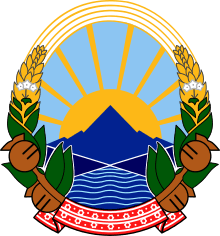Macedonian parliamentary election, 1990
 |
| This article is part of a series on the politics and government of the Republic of Macedonia |
|
Parliamentary elections were held in the Socialist Republic of Macedonia on 11 November 1990, with a second round on 25 November.[1] They were the first competitive elections in the country's history.[2] VMRO-DPMNE emerged as the largest party, winning 38 of the 120 seats.[3]
Electoral system
The 120 members of the Assembly were elected in 120 single-member constituencies. If no candidate received over 50% in the first round, a second round was held and contested by every candidate who received over 7% of the vote in the first round.[2] In the second round a majority was not required, and the candidate who received the most votes won the seat.[2]
Results
| Party | First round | Second round | Seats | ||
|---|---|---|---|---|---|
| Votes | % | Votes | % | ||
| League of Communists of Macedonia–Party for Democratic Transformation | 234,369 | 21.8 | 220,748 | 27.7 | 31 |
| Party for Democratic Prosperity | 165,388 | 15.4 | 58,046 | 7.3 | 17 |
| VMRO-DPMNE | 154,101 | 14.3 | 238,367 | 29.9 | 38 |
| Union of Reform Forces | 142,564 | 13.3 | 128,449 | 16.1 | 11 |
| Socialist Party of Macedonia | 77,123 | 7.2 | 38,893 | 4.9 | 4 |
| PDP-NDP | 62,628 | 5.8 | 13,326 | 1.7 | 5 |
| Movement for All-Macedonian Action | 42,926 | 4.0 | 8,803 | 1.1 | 0 |
| SRS-MDPS | 32,799 | 3.0 | 31,236 | 3.9 | 6 |
| Workers Party | 31,591 | 2.9 | 2,923 | 0.4 | 0 |
| Macedonian People's Party | 26,151 | 2.4 | 4,806 | 0.6 | 0 |
| Social Democratic Party | 16,972 | 1.6 | 1,656 | 0.2 | 0 |
| Party of Yugoslavs in Macedonia | 16,898 | 1.6 | 13,331 | 1.7 | 2 |
| Democratic Union-Party of Peasants | 13,230 | 1.2 | 4,829 | 0.6 | 0 |
| League for Democracy | 13,097 | 1.2 | 2,707 | 0.3 | 0 |
| SPM-MDPS | 5,960 | 0.6 | 7,061 | 0.9 | 1 |
| People's Democratic Party | 4,597 | 0.4 | 4,105 | 0.5 | 1 |
| PCERM-SPM | 3,757 | 0.3 | 3,961 | 0.4 | 1 |
| Democratic Alliance of Turks | 3,384 | 0.3 | – | – | 0 |
| Christian Democratic Party | 2,779 | 0.3 | – | – | 0 |
| PCERM | 2,359 | 0.2 | – | – | 0 |
| Workers-Peasant Party | 1,896 | 0.2 | 726 | 0.1 | 0 |
| MAAK/VMRO-DPMNE | 1,698 | 0.2 | – | – | 0 |
| SRS-SDPM | 732 | 0.1 | – | – | 0 |
| Union of Pensioners of Bitola | 428 | 0.0 | – | – | 0 |
| Independents | 18,157 | 1.7 | 12,769 | 1.6 | 3 |
| Invalid/blank votes | 60,144 | 5.3 | 34,476 | 4.1 | – |
| Total | 1,135,728 | 100 | 831,218 | 100 | 120 |
| Registered voters/turnout[a] | 1,452,072 | 77.2 | – | ||
| Source: State Election Commission; Nohlen & Stöver | |||||
a Includes the 113,051 voters in the first round who were not registered, but voted using their ID cards.[4]
References
This article is issued from Wikipedia - version of the 5/27/2016. The text is available under the Creative Commons Attribution/Share Alike but additional terms may apply for the media files.